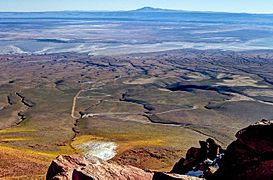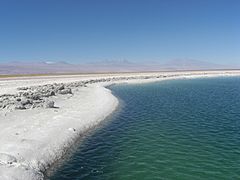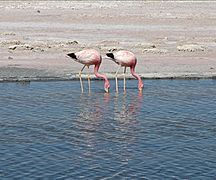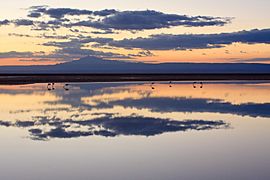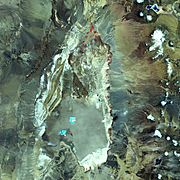Salar de Atacama facts for kids
The Salar de Atacama is the biggest salt flat in Chile. It's located about 55 kilometers (34 miles) south of San Pedro de Atacama. Imagine a huge, flat area covered in salt, surrounded by tall mountains!
To the east, you'll see the main chain of the Andes mountains. To the west, there's another mountain range called Cordillera de Domeyko. Many impressive volcanoes stand around the salt flat. These include Licancabur, Acamarachi, Aguas Calientes, and Láscar. Láscar is one of Chile's most active volcanoes!
In recent years, the Salar de Atacama has become very important for getting lithium. Lithium is a metal found in the salty water (called brine) under the salt flat.
The Likan Antay are the native people who have lived in this area for a very long time.
Contents
Amazing Features of the Salt Flat
This huge salt flat covers about 3,000 square kilometers (1,158 square miles). It's about 100 kilometers (62 miles) long and 80 kilometers (50 miles) wide. This makes it the third largest salt flat in the world! Only Salar de Uyuni in Bolivia and Salinas Grandes in Argentina are bigger.
The Salar de Atacama is about 2,300 meters (7,546 feet) above sea level. The middle part of the salt flat is quite bumpy. This is because of the way water evaporates and leaves salt behind. Other salt flats, like Salar de Uyuni, are often covered by shallow water, making them smoother.
Some parts of the Salar de Atacama are protected within the Los Flamencos National Reserve. You can find a special lake there called Laguna Cejar. It's a sinkhole lake about 18 kilometers (11 miles) from San Pedro. This lake has a lot of salt, from 5% to 28% salt! At the higher end, the water is so salty that you can float easily, just like in the Dead Sea.
How the Salt Flat Formed
The Salar de Atacama is part of a larger dip in the land. This big dip is like a giant bowl that has been sinking over time. Scientists think this sinking happened because of a very heavy block of rock deep underground. This heavy block stayed lower than the rest of the Andes mountains.
Millions of years ago, this area was part of a rift, which is like a crack in the Earth's crust. Over time, different layers of volcanic and sedimentary rocks built up in this basin. Later, big movements in the Earth's crust tilted these rock layers.
Water Sources for the Salar
The Salar de Atacama basin is surrounded by mountains and other river basins. To the north, it borders the Salado River basin. To the east, the border is close to the international line with Bolivia. This area includes volcanoes like Cerros de Tocorpuri, Sairecabur, Curiquinca, Licancabur, and Juriques.
The main rivers that flow into the Salar de Atacama are the San Pedro and Vilama rivers. They start north of the salt flat. Sometimes, volcanoes to the east can add salts to these rivers as they flow into the Salar.
Lithium: A Key Resource
The Salar de Atacama is located in what's called the "Lithium Triangle." This area is famous for having a lot of lithium. The Salar de Atacama is the world's largest and purest active source of lithium. In 2017, it provided about 36% of the world's lithium carbonate!
The salty water (brine) in the Salar de Atacama has a very high amount of lithium. Also, the area has a very high evaporation rate and almost no rain. These conditions make it easier and cheaper to produce lithium here than in other places, like the Salar de Uyuni.
However, getting lithium from the ground uses a lot of water. This has caused some disagreements with local communities. It can also harm the local environment, including the Andean flamingos that live there. The native Likan Antay have sometimes opposed lithium mining. But they have also worked with mining companies to share the benefits. These talks follow an international agreement that Chile signed in 2008.
Besides lithium, another element called boron is also taken from the brines. It's used to make boric acid.
Two of the biggest lithium companies in the world, Sociedad Química y Minera (SQM) and Albemarle, operate in the Salar de Atacama.
The process of getting lithium starts with pumping the salty brine out of the ground. Then, this brine is put into large ponds where the sun evaporates the water. This makes the brine much richer in lithium. This evaporation step can take 12 to 18 months! After that, the concentrated brine is sent to processing plants near the city of Antofagasta. There, pure lithium products like lithium carbonate are made.
Gallery
See also
 In Spanish: Salar de Atacama para niños
In Spanish: Salar de Atacama para niños




